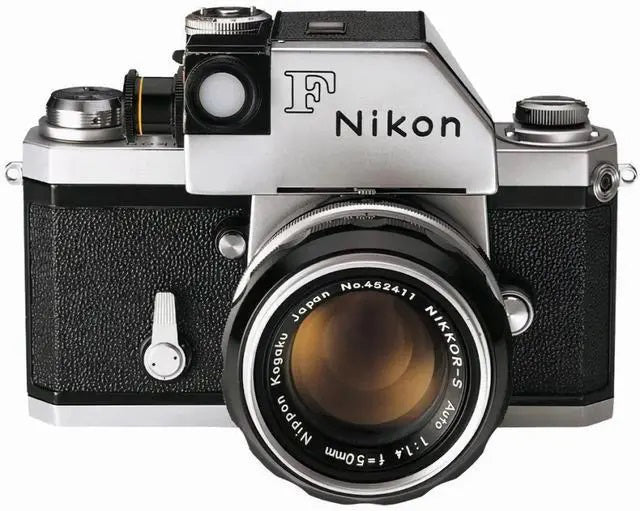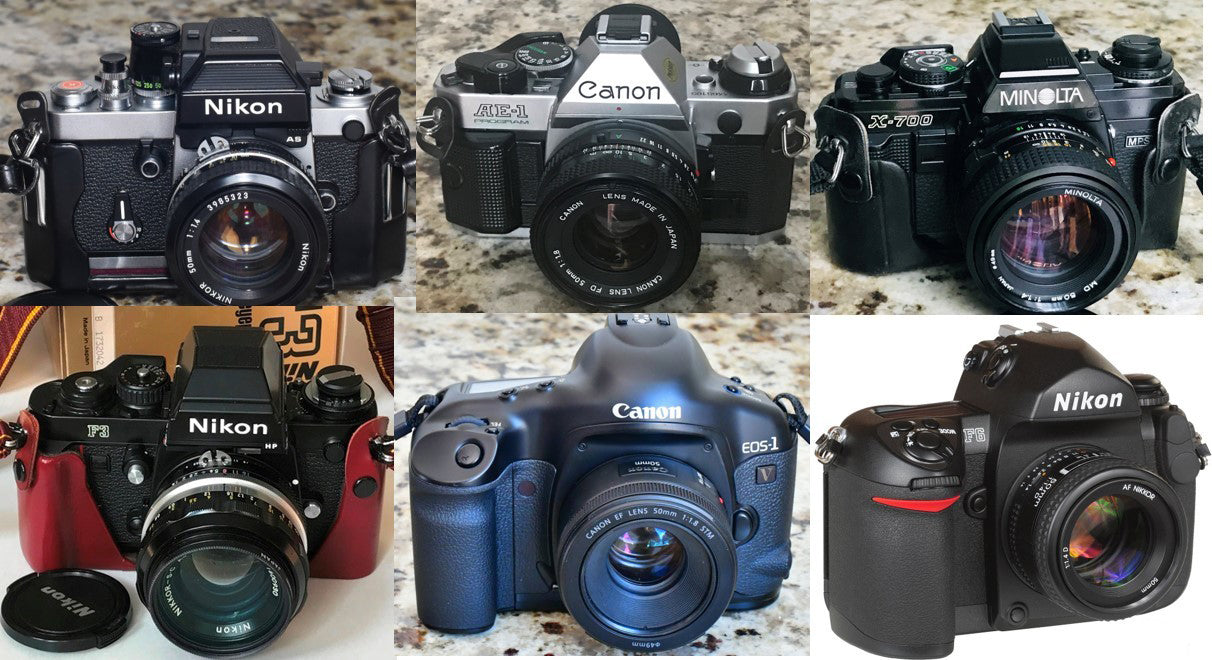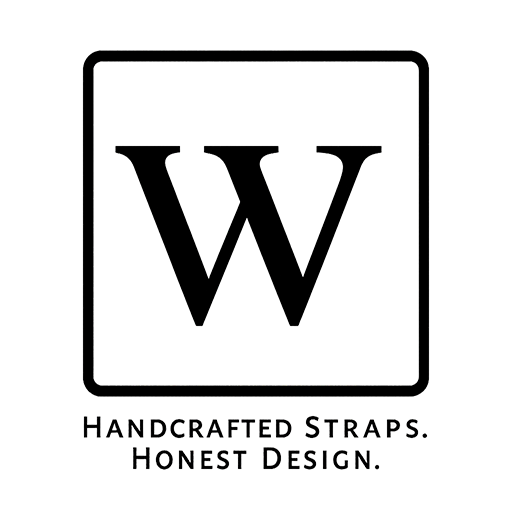
Best 35mm film SLR cameras

There are various versions of the best film camera on the Internet, as well as various titles of "magic camera". Based on my own experience and years of experience, I selected the best 35mm film SLR camera and gave a score at the end. Most of the cameras I selected have been used in person and have been specifically introduced. My selection criteria are mainly camera performance and quality, and also take into account market volume and other factors. I divided the 35mm film SLR camera into three categories: manual focusing mechanical camera (no battery required, manual focusing), manual focusing electronic camera (battery required, manual focusing), and automatic focusing camera.
First: Best manual focusing mechanical cameras
- Nikon F, the most important SLR camera in history, is of great significance for collection, especially the version with serial number 640xxxx in 1959. The later FTn photometry version, especially the Apollo version, is more convenient to use. Big F is very reliable, but today it seems that it is relatively outdated after all. Its metering performance is outdated and heavy, so it is not as convenient as later cameras.
- Nikon F2, the king of mechanical cameras, is the most widely recognized and reliable professional mechanical camera, which can be collected and used. Especially titanium alloy version, F2SB, and F2AS version are the most popular. F2 is probably the most reliable camera among all cameras, and the failure rate is still the lowest. However, it is still relatively heavy and not as easy to use as the later cameras.
- Nikon FM2, a mechanical camera with the largest output, powerful performance, small and light weight, classic shape and extremely reliable, is the backup for most professionals even in the era of electronic automation, and has no competitors.
- Nikon FM3A, the upgraded version of FM2, is the only mechanical/electronic hybrid camera and the last king of manual cameras, with low output and high collection value.
- Canon F-1 is similar to Nikon F2, but the market is small, solid, strong and heavy.
- Canon F-1N, mechanical/electronic hybrid camera, Canon's top manual camera and Nikon F3 are competitors, but the market is small.
Honorably nominated cameras:
- Nikon FM, the previous generation of Nikon FM2, has the same shape and high cost performance.
- Nikomat, its workmanship is extremely high quality, but its function is relatively old and heavy.
- Canon FTb is an excellent amateur fund made by Canon, with high cost performance, but it is old and heavy in function.
- Canon EF, Canon's mechanical/electronic hybrid camera, has excellent workmanship and is relatively heavy.
- Minolta SRT-101/102, the largest number of mechanical cameras in Minolta, has high cost performance, but is relatively old and heavy.
- Olympus OM-1n, Olympus's most popular SLR camera, is small, delicate, and very beautiful, but with older functions.
- Olympus OM-3, a mechanical camera with strong performance of Olympus, has low output.
- Pentax Spotmatic, Pentax's most successful early SLR camera, M42 screw, is reliable in performance, cost-effective, but with older functions.
- Pentax K1000, the most famous and most productive SLR camera of Pentax, is synonymous with student camera. It's just a weak function.
- Pentax KX, a powerful and reliable mechanical SLR camera of Pentax.
- The Pentax MX, the smallest mechanical SLR camera in the world, is just not strong and reliable enough.
- Contax S2b, Contax's top mechanical SLR, accepts ZEISS/YASICA lenses, but its cost performance is low.
- Leica R6.2, the quality of Leica cameras, is based on the Minolta XD7, but the cost performance ratio is low.
- Fujica ST801, Fuji's top SLR camera and the most powerful M42 bayonet mechanical camera.
Second: Best manual focusing electronic cameras
- Nikon F3, the most powerful and reliable electronic manual camera, selected by 70% of professionals, is the king of manual cameras.
- Nikon FE2, the most powerful and reliable amateur manual camera, has more aperture priority than FM2 for automatic exposure and TTL automatic flash. The shutter speed of 1/4000 seconds and the flash synchronization speed of 1/250 seconds have no competitors.
- Nikon FA, the only manual SLR with matrix metering (i.e. multi area evaluation metering), has four exposure modes: manual exposure, aperture priority, shutter priority, and program exposure. There is no competition between 1/4000 second shutter speed and 1/250 second flash synchronization speed.
- Canon A-1 has complete functions, including manual exposure, aperture priority, shutter priority, and program exposure mode, with high cost performance. The shutter speed is low.
- Canon AE-1 Program, the most popular entry-level model, is simple and easy to use. It can be used as a half fool's machine and also be competent for more complex shooting needs.
- Minolta X-700, the largest camera ever produced by Minolta, is the king of cost performance and has complete functions. Although it is an amateur camera, it is the top half of a professional camera.
- Olympus OM-4T, Olympus's strongest SLR camera, multi-point metering, titanium body. Unfortunately, the camera selection is limited.
- Pentax LX, Pentax flagship, excellent function, mechanical/electronic hybrid shutter, sealed design, small and light. Unfortunately, the failure rate is high.
Honorary nomination award:
- Nikon EL2, excellent workmanship is extremely rare in electronic cameras, and its performance is close to Nikon FE.
- Nikon FE, the previous generation camera of FE2, has a very high cost performance ratio, Nikon quality, and wide lens acceptance.
- Nikon FG, a boutique camera in the entry-level model, is small and delicate. Like all Nikon SLR cameras above, it has a mechanical backup shutter (you can take pictures without batteries). The workmanship is not as good as that of Nikon FE, but it is not inferior to that of similar products of other brands.
- Canon AE-1, the previous generation of Canon AE-1 Program, has huge output and easy access to maintenance parts.
- Canon T90, the most automated manual focusing SLR camera, has powerful functions. Unfortunately, the failure rate is high.
- Minolta XK, Minolta's flagship manual SLR camera, but the electronic part is still immature and the output is low.
- Minolta XD7, a high-end Minolta model, is beautiful and easy to use. Unfortunately, the failure rate is high.
- Minolta X-500 (X-570), Minolta X-700 minus the program exposure function, but there are improvements and low output.
- Pentax K2, the best flagship of Pentax cameras before cutting corners, has a low degree of electronic automation.
- Pentax ME Super, Pentax's most popular amateur SLR, is extremely compact and has a mechanical backup shutter (without batteries).
- Pentax Super A, Pentax's second only to LX's manual SLR, has manual exposure, aperture priority, shutter priority, and program exposure modes, which are cost-effective.
- Olympus OM-2 has the same shape as Olympus OM-1, which has increased aperture priority for automatic exposure.
- Contax RTS III, the flagship camera of Contax, has strong performance and accepts ZEISS/YASICA lenses. Unfortunately, the failure rate is high.
- Leica R9, Leica's ultimate film SLR, can be fitted with a digital back.
Third:Best autofocus cameras
- Canon EOS 1N, Canon's flagship auto focusing machine, makes Canon surpass Nikon's decisive camera. Every aspect of the performance is excellent, but the BC reports a slight error.
- Canon EOS 1V, Canon's ultimate flagship machine, is almost perfect and very close to a digital camera.
- Canon EOS 3 is close to EOS 1V, which is better than 1N. It also adds eye control focusing, although not as accurate.
- Nikon F4, Nikon's first professional auto focusing machine, has a traditional control interface with no menu. Strong performance, the widest lens compatibility, but the auto focus is relatively primitive. Porsche designers are its highlights, and the appearance is liked by many photographers.
- Nikon F5, the only block film machine and the strongest tank, has strong performance and accurate focusing. It's just heavy.
- Nikon F6, the last glory of Nikon film camera, is the best SLR camera with high price and suitable for collection.
- Nikon F100, commonly known as small F5, can meet most of the needs of F5 users. The only drawback is that the camera back cover buckle is easy to break.
- Minolta a9, the final professional machine of Minolta, has strong performance, but the plastic handle is easy to age and fracture.
- Minolta a7, the most advanced film SLR camera of Minolta, is close to digital technology.
Honorary nomination award:
- Canon EOS 5, a quasi professional with powerful functions, has a high failure rate.
- Canon EOS 50, an amateur camera with good comprehensive performance, is suitable for most photographers.
- Canon EOS 7, with advanced performance compared with EOS 5 and EOS 50, and moderate price, is the best choice for amateurs.
- The Nikon F90s has strong performance. Although it is not as advanced as the F100, it is very solid and reliable, and is compatible with the manual focusing lens.
- Nikon F80, with advanced performance, perfectly matches the digital lens, small and light, is the best choice for amateurs, but it is not compatible with the manual lens, and the buckle of the back cover is easy to break.
- Minolta a9xi, Minolta's flagship camera in the medium term, has strong performance.
- Minolta a800si, Minolta's later quasi flagship camera, has strong performance and high cost performance.
Finally, by the way, Canon AE-1 is the first electronic automatic SLR camera with microprocessor, which is of epoch-making significance. It made the SLR camera that was previously considered to be difficult to control and could only be used by professionals become available to the general public. At that time, it was very sensational and its sales volume was unprecedented. Note that the improved AE-1 Program of AE-1 is also included. Because the font of the Program is very small, people often confuse the AE-1 Program and AE-1. In fact, they are two different cameras. The AE-1 Program is much better. Nikomat was the highest quality amateur camera at that time, with huge sales. FM2 is Nikon's most popular mechanical SLR, so it has the longest production time and huge sales volume. Srt-101 was the most advanced and cost-effective SLR camera at that time, so its sales volume was huge. X-700 was the most advanced and cost-effective SLR camera at that time, so it had the longest production time and huge sales. Olympus OM-1 pioneered the miniaturization of the SLR camera, which is very popular and therefore has a huge sales volume. Pentax Spotmatic was the most popular M42 screw SLR camera at that time, making the M42 screw also known as Pentax screw, with a huge output. The K1000 is the simplest and cheapest SLR camera. It is the king of student cameras and is widely known. It is Pentax's camera with the longest production time and the largest output.


